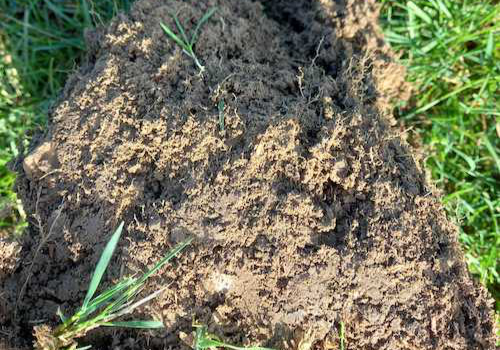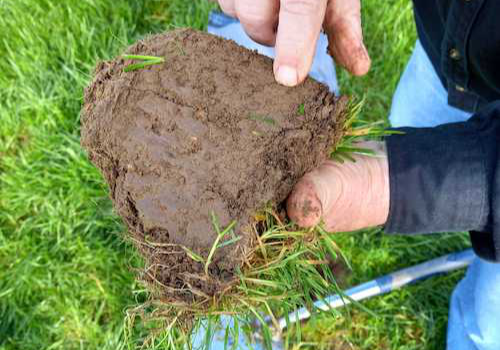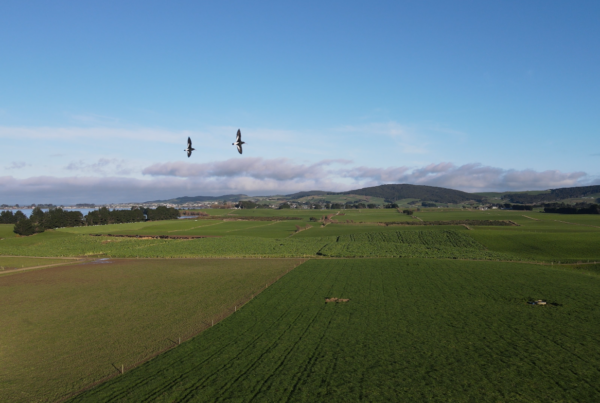We all aim to set ourselves up to get through winter as best we can – to hit the ground running early in spring when our production needs to kick into gear and quickly ramp up. One tool in the kit is aerating the soil. Aeration is perhaps under-utilised in New Zealand, but studies have shown that this land management practice can have a big impact on production levels. Mechanically or via crop species with rooting structures to do the job naturally, aeration deserves serious consideration.
Heading into winter we all know what’s coming – cold, rain, and mud… But what does this mean for our soils and how can we help them get through winter, and all its puggy glory, in the best possible shape to support spring growth?
Benefits of Aerating
Aerating the soil can be hugely beneficial. Just like above ground, air is a crucial component for vigorous life below ground – so compacted and waterlogged soils are naturally less productive.
Soil compaction occurs over time as soils are repeatedly subjected to stock trampling and machinery usage. Farm systems with heavy soils, larger animals, densely grazed areas and high traffic loads within or across paddocks are often more compacted. Aerators disrupt and penetrate compacted layers creating an open and porous soil that air, moisture, and roots can penetrate more easily and deeply.
Improved soil aeration allows:
- Improved Soil Drainage: the ability of water to drain improves – surface water can drain down into the subsoils reducing ponding and surface runoff.
- Deep Root Growth: when soil compaction is reduced, roots can grow deeper and more vigorously – resulting in enhanced plant health & yield. Productivity can be improved by up to 30% in a relatively short time frame.
- Fertiliser Response: There is a higher percentage of fertiliser waste on compacted soils as it is more likely to vaporise into the atmosphere or wash off. When soils are permeable, fertiliser absorbs down to the plant root zone more easily, resulting in more fertiliser being accessible by the plant and reduced surface runoff.
- Better Soil Porosity: As compaction is removed & the amount of macropores increases, so does the amount of moisture and nutrients available to the roots.
- Productivity Gains: All of these benefits promote a healthier, more resilient, higher productivity plant.
How do I know if my soil would benefit from aeration?
Stan Winter, Soil Scientist gives some great advice on how to determine whether your soils would benefit from aeration. “The most obvious indicator is surface water being held in your soil – those wet spots that you can’t drive easily through and never seem to improve. Rushes are also an indicator that you are likely to get a good response from aerating.”
Spring is usually touted as the best time to aerate due to stronger root growth at this time of year, but autumn aeration deserves consideration too. If winter pugging or water logging is a concern, it may be of significant benefit to aerate the soil in autumn (either instead, or as well as spring) to reduce damage throughout winter. Improved soil drainage creates a more resilient soil structure with less surface water retention. Waterlogged soils coming out of winter reduce ground temperatures, meaning a later start to your spring pasture growth.
Stan advocates a simple test – dig a hole to spade depth under a fenceline as your control site, then another out in the paddock. Note the difference in the difficulty to dig the two holes – this indicates compaction. The root depth of the turf from these holes will also indicate whether there is a problem or not. Roots should be growing deeply to the depth of the spade or more. Rusty flecks in the soil indicate water being held in soils above a compacted pan. “Patchy grass growth is a real indicator too”, says Stan, “especially where fertility levels are increasing but not being matched by increasing productivity”. And finally, no mushrooms! “Lack of fungi growth is less well known but pretty indicative of compacted soils”.
Good structure
sample taken from under the fence-line demonstrating good structure.


Poor Structure
Sample taken from the paddock demonstrating poor structure.
Cooper Walton, from Rata Equipment comments, “You can get powerful results in terms of reducing the propensity for pugging and water-logging by aerating in autumn. Particularly if you get strategic with your pull direction and land slope”. “Prevention is always a better option than trying to rectify pugging afterward, so this builds the case for autumn aeration for a lot of farmers.” “You may not get the same immediate lift in initial production level as you do by aerating in spring, because you are not going into such a growth period, but it means you can come out of winter in better shape.” “Timing in spring is also more crucial as you want to avoid going straight into a dry period after aeration.”
Aeration and nutrients
The availability of nutrients for crops directly relates to the degree of soil aeration. Well-aerated soils provide more favourable growth conditions, while nutrient imbalance and poor aeration impede plant development. The impact of soil aeration on nutrient supply is as follows:
Nitrogen. Organic nitrogen fixation and mineralization are carried out with nitrogen-fixing plants (especially legumes), organic matter, and livestock wastes. Organic nitrogen is reduced to plant-digestible forms by aerobic bacteria that can function properly only under sufficient soil aeration. Poor aeration induces a split of nitrates to nitrous oxide (N2O), which is among the potent gases contributing to the greenhouse effect. Besides, denitrifying bacteria are more likely to deprive crops of nitrates in poor earths. This happens because most denitrifying bacteria are facultative aerobic. It means that when O2 is available, they will use it (aerobic respiration). When the O2 level is poor, they will switch to NO3 or NO2 (anaerobic respiration).
Manganese and iron have high valence in well-aerated soils and low valence in poorly-aerated ones. Although plants can consume only low-valency forms, their excessive absorption is harmful to crops. For this reason, excessive access to low-valency forms must be limited, and toxicity risks are mitigated with aeration.
Sulfur is represented by sulfate in aerated soils, which is suitable for plants. Sulfate turns into sulfide under poor aeration (waterlogging), and hydrogen sulfide is harmful to crops, too.
Nutrient imbalance results in the deviance of root formation, which will inevitably affect the whole plant and cause yield losses. Signs of poor aeration include thick, short, dark roots of abnormal shapes, poorly developed hairs, etc.
When is the right time for aeration?
Soil moisture levels are very important when it comes to getting the timing right for aeration. In both autumn and spring, soils must be moist and friable for best results. Hamish McCallum from Fish IT has worked on aeration with many clients and has seen great success stories. “You can measure soil moisture content technically, but there is an easy way to determine if soil condition is right for aeration. Take a tennis ball size amount of soil and roll it into a ball in your palm, then drop it from shoulder height. It should break into 3 or 4 pieces. If it crumbles it is too dry, splodges it is too wet.”
“Nothing can thrive in an anaerobic environment. So, when we aerate and then feed the soil bugs, we get fantastic results.”
Dennis Niewkoop of 4Seed & Nutrition Ltd agrees. “Beneficial soil microbes require air first and foremost to operate and do their job of transferring nutrients to plant roots. There is a journey to go down to get our soils functioning optimally. Once we have adequate aeration, good soil structure, and the right mineral balance then fish products are proving to be the connection to keep stimulating soil biology, particularly fungi. New Zealand soils are typically low in beneficial fungi”.
“Soil is a living thing and therefore needs to breathe” according to Rik Mulder from Soil Matters. “The soil’s ability to breathe depends on several factors, but for long term resilience in your soil it is important to start with the big picture elements like drainage and soil mineral balance. To manipulate these factors, it is very important to have a good understanding of your soil and soil type as these will have a strong impact on what the right approach is to get air in your soil. Once the big picture building blocks are in place, more emphasis can be given to the living things.”
Dennis points out that mechanical aeration is only one way to improve aeration. “We are seeing great results from multi-species pasture mixes. Species with taproot depth and width and different rooting depths can provide valuable soil aeration. “What we are finding is that a multi-species summer crop can provide really good benefits to soil structure and porosity. Once a more permanent pasture is put in place, then mechanical aeration is great for maintenance.”
For more information on whether aeration is right for you contact Fish IT. If we can’t answer your questions, we can put you in touch with one of our expert partners for more advice.



